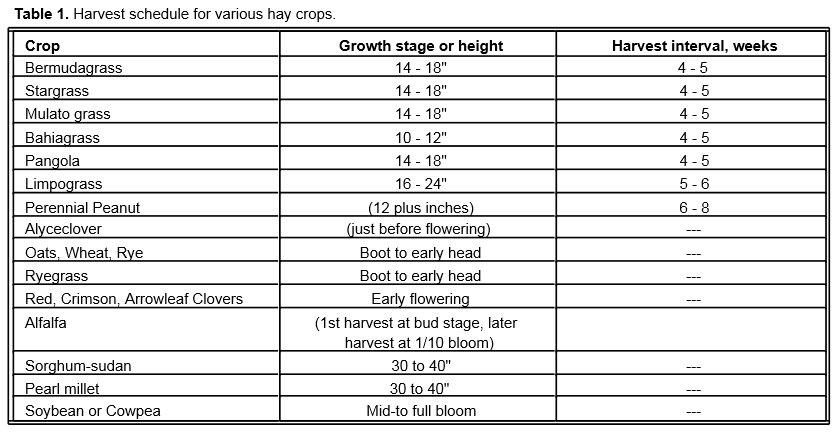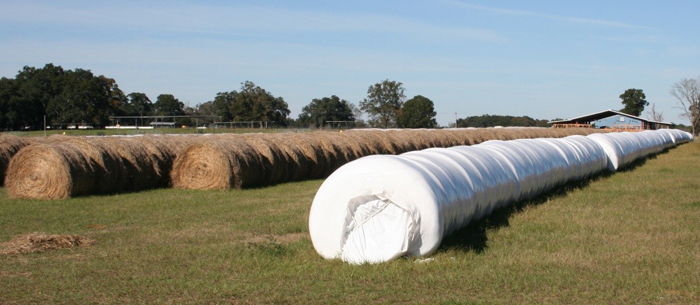Nicolas DiLorenzo, State Beef Specialist, University of Florida NFREC
With the hay season in full swing, we are now ready to reap the benefits of the combination of temperature and moisture to be able to (hopefully) lower our feed bill later in the year when the grass is gone. When you are reading this you may wonder “which moisture is he talking about?” since at least in Jackson County we had less than 2 inches of rain in the last 30 days, and the pastures look and feel very crunchy. While these past weeks have been abnormally dry, compared to previous years (we had 1.4 inches less than in June of last year and 5 inches less than in June of 2012), we are expecting some showers over the weekend that may bring much needed relief.
The nutritional quality of the forage we preserve now will impact the nutrition of the cow herd this fall and winter. Thus, now is a good time to think about some key decisions that may enhance the quality of our hay. Keep in mind that, accounting for the waste in dry matter intake when feeding, hay can be the most expensive feed in your operation.
One of the dilemmas we face every year is whether to make dry hay or baleage. While wrapping cost has decreased in recent years, we are still looking at an added cost of wrapping ranging from $4 to $9 per bale, so this needs to be weighed against the benefit. In the southeastern U.S., rain patterns make it very difficult to make hay in the summer, and even though today may not seem like a problem, just remember trying to make hay about a year ago. Wrapping wilted forage for baleage is typically done to avoid losses due to unpredictable rainfall. Remember: “The quality of the forage is not improved by the ensiling process that takes place during baleage, at best, the quality is maintained.” A reasonable approach is to make strategic use of wrapping to favor greater quality fields, while doing regular hay in poorer quality fields, where the losses due to rained-on hay may be lower. Research from the Noble Foundation in Oklahoma shows that for every inch of rain that falls once forages are cut, dry matter yield drops 5%, and digestibility of hay drops %10 percent.
Watch out for fall armyworms. While the peak of the damage is usually from August to October, July is typically when the first reports of damage occur. In this time of the year they can increase their population very rapidly, causing great loss in dry matter yields. There are a number of insecticides options labeled for armyworm control.
In summary here are some considerations to keep in mind for the 2014 hay season:
- Haylage or baleage does not improve the quality of the forage. The quality is determined much earlier by factors such as choice of forage, management (e.g., cutting time), and the fertilization program.
- Cows need to eat pounds of dry matter. When feeding baleage you need to keep in mind that you are baling 50 to 60% water. Do not be surprised if your cows consume a lot more bales o fbaleage than they typically do of dry hay.
- Create the habit of analyzing hay at least once a year from each field to have an idea of the quality of the feed and future needs for supplementation, if any. There are some affordable options for the sample analysis for basic nutrient contents such as crude protein (CP) and Total Digestible Nutrients (TDN) at the Forage Extension Laboratory, located at the Range Cattle Research and Education Center in Ona, FL.
- Watch for fall armyworms and spray if necessary. Pay close attention to labeling restrictions of the number of days between application and hay harvest.
- Cut at the optimum interval and height to maximize both yield and forage quality. Although the frequency varies with each forage type, common forages in the Panhandle can be cut every 4 to 5 weeks, when they reach 10 to 14 inches of height. After 6 weeks, yields increase only slightly but quality is reduced significantly. A detailed harvest schedule for various hay crops can be found in Table 1 below.

Source: SS AGR 70 Hay Production in Florida: http://edis.ifas.ufl.edu/pdffiles/AA/AA25100.pdf
- 2025 Florida Bull Test Sale Sets Average Price Record - March 7, 2025
- 2025 Florida Bull Test Sale – January 18 - January 10, 2025
- Intake Limiters:Old Technology for Modern Beef Cattle Supplementation - September 20, 2024

